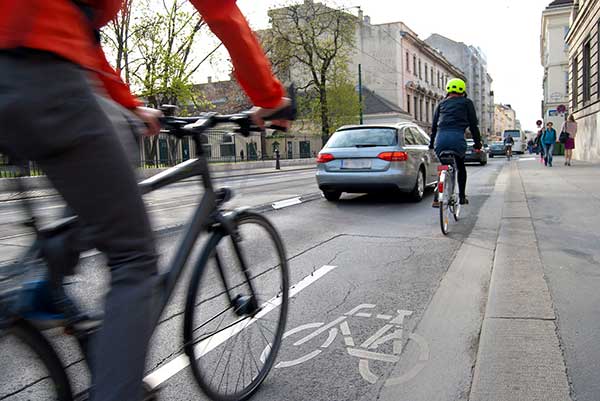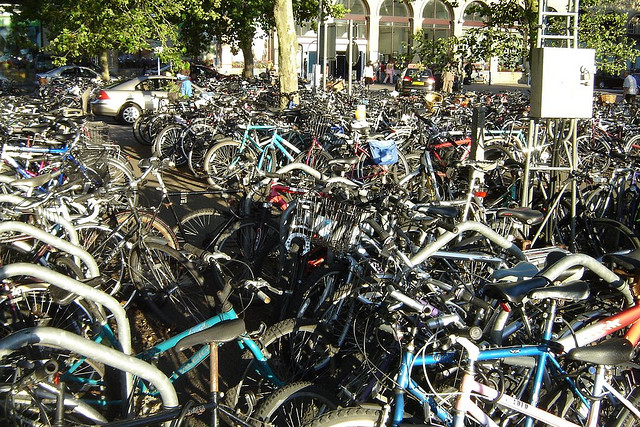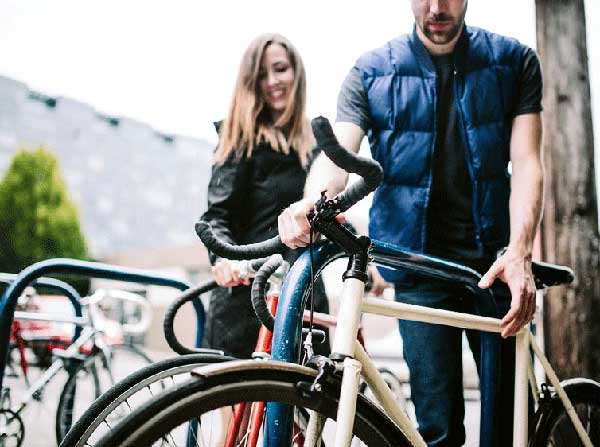 With a record number of bicyclists in America today, it would be wise for cities to seek a "bike friendly" designation by adding more bike lanes and bike parking racks
With a record number of bicyclists in America today, it would be wise for cities to seek a "bike friendly" designation by adding more bike lanes and bike parking racks
Is your city a bicycle-friendly community with plenty of bike lanes, bike parking racks, and safer streets? It can mean the difference between getting with the times or having people avoid living in your city altogether.
Bicycle commuting is on the rise. Since 2005, the share of bicycle commuters increased at a national average of 46%, but some states have seen an increase of more than 100%. This is good for everyone, but especially the environment and the health of individuals within the community.
Bicycle commuters are so passionate about continuing to bike to work that they are willing to specifically move to bicycle-friendly cities. If your city isn't bike friendly, it might be slowing its growth.
If you want to keep up with modern trends, earning a bicycle-friendly distinction is key. The most well-known certification is through the League of American Bicyclists. Since counties, towns, and cities all earn their stamp of approval, the League refers to the distinction as a Bicycle-Friendly Community.
The League of American Bicyclists certifies Bicycle-Friendly Communities in the levels of Bronze, Silver, Gold, Platinum, or Diamondâ€â€Âthe highest level (Diamond) is rarely achieved, since it sets the absolute highest standard for communities. While there is no exact method for earning a rank, the League breaks the qualification into a few important factors.
 If cities are going to encourage more people to commute by bicycle, they will need to offer an adequate number of bike parking racks at key locations
If cities are going to encourage more people to commute by bicycle, they will need to offer an adequate number of bike parking racks at key locations
Key outcomes: These are the main goals as a result of the other efforts listed below. A few outcomes include ridership, or percent of people commuting by bicycle, and crashes/fatalities per 10,000 daily commuters. The Diamond level has 20% ridership, 50 crashes per 10,000 daily commuters, and only 0.2 fatal crashes.
Enforcement: Bicycle-friendly laws and ordinances, along with law enforcement support such as a bicycling liaison, are a major key to earning Bicycle Friendly Community status.
Education: Public education outreach and annual adult skills classes earn you credit in this category. You will also want a high percentage of primary and secondary schools offering bicycling educationâ€â€Âat least 33% for the Bronze level.
Engineering: Your city's bike access to public transportation needs to be at least "good." Total bicycle network mileage to total road network mileage should be at least 26% for the Bronze level, while at least 33% of arterial streets need to have bike lanes.
Evaluation: Your city needs to have at least one dedicated bike program staff person. Depending on your city size will determine whether or not only one is enough. A current bike plan should be in place, with ongoing implementation. However, designating a staff member to concentrate just on bicycle planning shows the city is focused on making strides with their bicycle infrastructure.
There is quite a bit of planning involved in creating bike-friendly streets, and someone must be an advocate for bicycles when changes are proposed for roads, retail establishments or housing.
Encouragement: A few ideas for qualifying your city in the encouragement category include: active bike clubs and signature events, bike month and bike to work events, an active bicycle advisory committee and advocacy group, and recreational facilities like bike parks and velodromes.
 A couple uses bike parking racks in Portland, one of the most bike friendly cities in the US. The city will actually install commercial bike racks at no charge in front of businesses that request them
A couple uses bike parking racks in Portland, one of the most bike friendly cities in the US. The city will actually install commercial bike racks at no charge in front of businesses that request them
Another critical issue is where to store all of those bicycles. As cities built out their bicycling infrastructure, they are also building out their bicycle parking strategies. That includes adding more bike parking racks to garages, installing commercial bike racks at no charge in front of businesses that request them (popular in Portland) and also requiring the addition of bike rooms to provide secure, long-term bicycle parking in new apartment buildings or office buildings. Zoning officials are also requiring the installation of more commercial bike racks at stores and other facilities.
The League of American Bicyclists quotes city planners on their website to show testimonials of what the ranking means for their community.
"It built recognition of what we have done, which helps to get funding for the very long list of what we still have to do," said Wayne Feiden, Director of Planning and Development in Northampton, Massachusetts. "Having the honor actually made it easier for us to give a frank assessment of where we lag and help build political support for future phases."
More Americans own bicycles today than ever before. A bicycle is a favorite form of transportation for Millennials. Cities are now going on "road diets" and changing their focus from building more highways to creating more bikeways. If you want to find a solution to pollution and smog in a city, add more bicycles and restrict more cars.
In addition, tourists love to explore a city by bicycle. Promote bicycle tourism. Create bike trails that lead people to popular places. Provide plenty of bicycle parking at tourist attractions. Help tourists leave their cars at home and pedal around your town instead.
Many cities are seeing the enormous benefits of becoming more bicycle-friendly and emulating European cities such as Copenhagen where an incredible 50% of people their use a bike to commute to work. Adding more bike lanes and bike parking racks is certainly much less expensive than building a road, bridge or railway.
For more information about how to get your city ranked as a Bicycle Friendly Community, check out this helpful infographic by The League of American Bicyclists.


